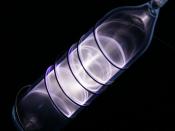Noble gases make up group 18 in the periodic table. There are six in total: Helium, Neon, Argon, Krypton, Xenon, and Radon. Noble gases are relatively unreactive. Until 45 years ago, noble gases were believed to be entirely inert because their oxidation number of 0 prevents the noble gases from forming compounds readily. Under normal conditions, noble gases occur as odorless, colorless, monatomic gases. All noble gases have the maximum number of electrons possible in their outer shell making them stable. This all changed in 1962 when Neil Bartlett, a chemist at the University of British Columbia, prepared the first noble gas compound, XePtF6. Today we use noble gases and their compounds frequently.
Helium's low density makes it perfect for uses in synthetic atmospheres to make breathing easier for people suffering from emphysema. Due to its nonreactivity (compared with flammable hydrogen) and lightness, is often used in blimps and balloons.
Helium is also used when people go deep sea diving. Research laboratories use helium as a liquid coolant to achieve very low temperatures. This is possible because of Helium's extremely low boiling temperature of -269C. Helium can be obtained from natural gas deposits and air. No conventional compounds of helium or neon have yet been prepared. Neon can be obtained from liquid air. To create a neon sign, a high voltage is passed through a glass tube containing neon at very low pressures. Neon is also used in television tubes and is often combined with helium in creation of helium-neon lasers.
Argon can be obtained from the air and is also used as an inert atmosphere in the synthesis of air and moisture sensitive compounds (as an alternative for nitrogen). Canisters containing argon can be used to extinguish fires without damaging server equipment. Argon is also used by museum...


